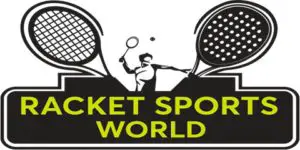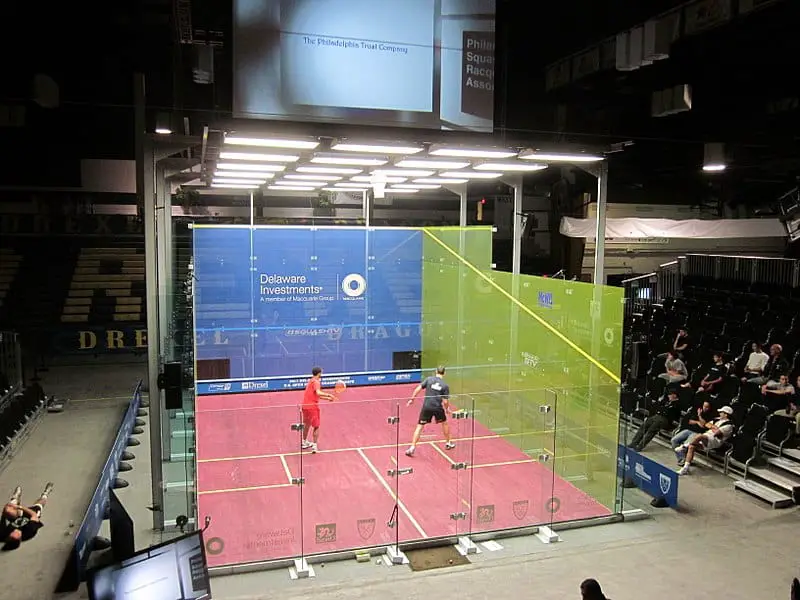You might be delighted to know that you are not the only one who is not sure if there is a difference between the two ball games, squash and racquetball. They are both indoor ball sports, they are both played with racquets and a small ball, and they are both played on a court with four walls and a ceiling.
So are squash and racquetball the same sport? No, they are in fact completely different despite the obviously similar-looking aesthetics.
Table of Content
Which came first, Squash or Racquetball?
Squash came first, originating in England in the 1830s.
It was a game that was played in London’s prisons in the 18th century. From prison, and you can see why squash would be a perfect prison sport, it spread to schools.
The first squash courts were built at the Harrow School in London, and from its humble beginnings in a prison, it is now played by more than 20 million people worldwide.
Racquetball, by contrast, was first played in the USA in the 20th century. It is likely that the game was influenced by squash, but was a combination of squash, tennis and handball.
Racquetball is much younger than squash, but there are also about 20 million players worldwide. The game is similar in design and style, but different in speed and rules (read more about racquetball rules here).
What are the primary differences between the two sports?
- The racquets in racquetball are a maximum length of 22 inches.
- The racquets in squash are a maximum of 27 inches.
- The ball in racquetball is 2.25 inches in diameter.
- The ball in squash is 4 cm in diameter.
- Squash is played in an indoor court.
- Racquetball can be played in an indoor or outdoor court.
We are going to talk a little more about the courts and the differences between the two.
We mentioned that a squash court is indoors but a racquetball court can be indoors or outdoors. The outdoors court for racquetball must be fully enclosed, just in case there is confusion.
Also Read:
Both courts are similar in size – 40 feet x 20 feet for racquetball and 32 feet x 21 feet for squash – and both are rectangular in shape.
The height of both courts is approximately 20 feet but the walls of the rectangular box do differ in height.
Both courts have lines that define the service area and the receiving area, and both courts have lines that define a net. In squash the net is generally 19 inches from the floor, and in racquetball there is no defined net.
In squash the ball must be hit over the net line. If it is below the net, it is considered a fault or out. If the ball hits the net line itself, it is called ‘hitting the tin’ and is out. If the ball hits the ceiling in squash, it is out. In racquetball, the ball can hit the ceiling.
The Objective of Racquetball
Once the ball has been served, the object to the game is to win points by winning rallies. The ball must be hit against the front wall and it must bounce once, before being returned.
Points are only scored when the server wins his serve, which is the same as squash. Points are lost if:
- The ball bounces twice before it is returned.
- The ball does not reach over the short line after hitting the front wall.
- The ball does not hit the front wall when a shot is played
- The ball goes into the out of bounds section, or over the walls.
- The ball hits the other player and was not heading to the front wall.
A racquetball match is the best of three games, and each game in a tournament is made up of 15 points. In a friendly game, racquetball can be up to 21 points, or in a cut throat game, 7 points.
The winner only needs to win by 1 point.
It’s a good idea to watch a few online videos to understand racquetball, the positioning of the players and of course, the various shots.
The Objective of Squash
Just like racquetball, the object of squash is to serve correctly, for the ball to bounce once and then be returned and for a rally to ensue. The object of the game is to win rallies and thereby win points.
A squash game is usually played up to 11 points in tournaments but 9 points in friendly games. The winner must win by two points, and a squash match is the best of three games too.
- The server must stand with one foot in his service box.
- The serve must hit the front wall above the service line.
- The serve must be below the out line.
- After hitting the front wall it must travel over the short line, to be returned.
- If it does not hit the short line, the server loses his serve.
- Once the ball has been served, and returned, with one bounce, a rally commences.
- Points are only scored when the server wins his serve. He gets two serves per point, meaning if the first serve is out or below the line, he can serve one more time. If he loses his serve, the serve goes to his opponent.
The Service in Squash
A service is underhand. The server does not bounce the ball before serving; the ball must be hit mid air. The server must have one foot in the service box and one foot outside the service box, to serve.
The Service in Racquetball
The service in racquetball is also an underhand serve but it can be served with our without a bounce. The server can stand anywhere he wants in the service box.
The Speed of the Games
Both of these games are quick. They are both fantastic games for people who want to get good exercise in a fairly short space of time.
You need to be fit to play squash or racquetball although of course you can get fit as you play the game.
Also Read:
Racquetball is sometimes thought to be the quicker of the two games because of the type of ball. A racquetball ball is bouncier, so the players have to work harder to reach up, down, around or over, to get to the ball.
A squash ball is a lot ‘squashier’ and not nearly as bouncy, which makes it a completely different challenge. The balls do in fact account for a lot of the difference in the two games, and if you watch both games you will pick up the differences quickly.
It’s not just the rules and the equipment that are different, it is the speed of the games that is different.
Note that squash is still a very quick game, just not as quick as racquetball.
Are either squash or racquetball an Olympics game?
Neither game has made it to the Olympics yet, but bear in mind the it took tennis a long time to reach the Olympics too. Interestingly, squash has come close to becoming an Olympics sport on a numerous occasions, so much so there was a report on BBC alluding to a legal challenge against its exclusion from the games.
The games are both played widely around the world, and there are national and international tournaments, as well as world championships.
You do not have to be a tennis player to play either sport, but having a knowledge of tennis does help. The shots are all the same – forehand, backhand, lobby, volley – but there is a lot more wrist action in squash and racquetball.
Who plays squash and racquetball?
Anyone who can hold the racquet! Both games are accessible and because they are fairly quick – you can get a great game in just half an hour – they are really popular games for people who are ‘on-the-go.’
Many gyms have squash and racquetball courts and you will find business people and students fitting in a quick lunch time game or an evening game.
Unlike tennis, you do not need hours and hours. Both games are played at schools, colleges and clubs, and while many people play recreationally and for fitness, many play professionally and competitively too.
A tennis purist would tell you not to play squash or racquetball at the same time as tennis, only because of the wrist action. They would tell you that if you play too much of one of these walled court sports, it will affect your tennis.
This is probably the case if you are playing professionally; it makes sense to focus on one sport and one style.
But players who are playing for leisure can alternate sports – most players can differentiate the wrist action needed for any of the games, and adjust accordingly.
Squash is fantastic. It’s quick, it requires skill, it requires energy and it requires strategy. Racquetball is fantastic too. It’s also super speedy, a game of skill, energy and fitness, and just like squash, a player needs to be strategic.
Try either sport, wherever you find a court. You only need a racquet, a ball, a pair of sneakers and an opponent. Most clubs rent out balls and it is always an investment to buy yourself a racquet – it will encourage you to play more!


